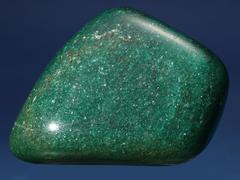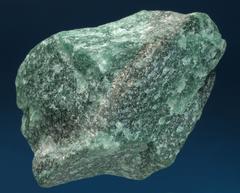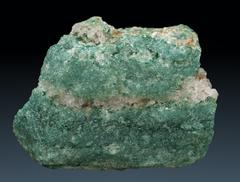Aventurine
Specific Properties
Occurrence
Locations and Specimen
Further Information
Specific Properties
Occurrence
Locations and Specimen
Further Information
Document status: incomplete
Although aventurine is usually treated as a quartz variety, it is not even a mineral in the strict sense. It is a rock, either quartzite or gangue quartz, that contains other minerals beside quartz grains, usually mica minerals which give it a metallic sheen. Some call it aventurine quartzite accordingly.
Calling it aventurine quartz helps to distinguish it from the orange to red aventurine feldspar which, except for being softer and sometimes more translucent, has very similar properties and appearance.
Specific Properties
Aventurine is identified by its metallic sheen, and can be of various colors, like green, red, orange, yellow, or blue. Most aventurine offered commercially is green. Due to its grainy structure aventurine has an irregular fracture, so raw, unpolished pieces have a rough surface similar to marble or quartzite. Different from marble, it is not porous, but mostly compact and dense, just like quartzite.
In green aventurine the color is often caused by a chromium-bearing muscovite called "fuchsite", K(Al,Cr)2AlSi3O10(OH)2, a mineral of the mica group.
Blue aventurine is sometimes labeled blue quartz, which is very confusing. The color is then often caused by dumortierite, (Al,Fe)7O3(BO3)(SiO4)3.
Occurrence
Locations and Specimen
Lots of good quality aventurine comes from India. Other sources are Brazil and Norway.
A rough specimen of unknown origin, probably India. It is slightly translucent and has a grainy structure. The golden sparkles are caused by tiny pyrite inclusions.
Norway
This piece of aventurine quarzite has a layered structure, and the fuchsite flakes are oriented parallel to the layers (horizontally in the image). Individual mica flakes can bee identified on fracture planes that run parallel to the layers of the rock. From Lurøy, Nordland, Norway.
Further Information, Literature, Links



